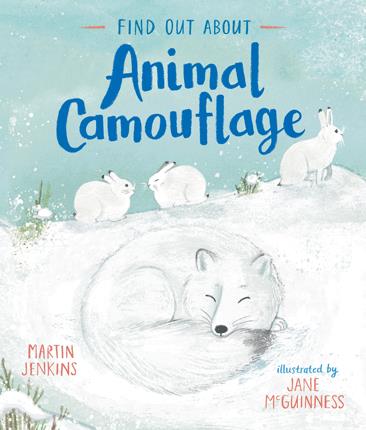| Find out about animal camouflage (Find Out About (Candlewick Press)) Author: Jenkins, Martin | ||
| Price: $23.08 | ||
Summary:
Discover some of the brilliant ways animals disguise themselves.
| Illustrator: | McGuinness, Jane |
Reviews:
Kirkus Reviews (09/15/23)
School Library Journal (12/02/23)
Booklist (10/15/23)
Full Text Reviews:
Booklist - 10/15/2023 English conservation biologist Jenkins has written many fine picture books on topics related to animals, including The Emperor’s Egg (1999), Can We Save the Tiger? (2011), and A Walk through the Rain Forest (2022). His latest book explains how camouflage can hide animals from both their predators and their prey. Resembling leaves enables some butterflies and moths to blend into their environments. Flower mantises hide among colorful blossoms, while animals with mottled, brown coloring, like frilled lizards, are hard to spot on old tree stumps. Jenkins also considers how animal camouflage works in deserts, in snowy habitats such as the Arctic, and on the ocean floor. Animals such as poison dart frogs and monarch butterflies have distinctive colors and markings, which warn predators that they’re dangerous and possibly poisonous. Other animals are protected by mimicry: looking like monarch butterflies or poison dart frogs can foil predators, too. The mixed-media illustrations are well-designed to support points made within the text. This colorful picture book provides a helpful introduction to camouflage in nature. - Copyright 2023 Booklist.
School Library Journal - 12/02/2023 PreS-Gr 1—The fourth book from Jenkins and McGuinness in their "Find Out About" nonfiction series introduces young children to animal camouflage and mimicry. With straightforward text (and a few playful asides to show that these normally quiet creatures have surprises), Jenkins defines camouflage as "[h]iding by blending," making the distinction that some animals hide because they are prey while others hide because they are predators. Creatures can take on the look of leaves, twigs, flowers, or tree stumps in a variety of different habitats, including the desert, ocean, and the snow—and some brightly colored poisonous or foul-tasting animals don't hide at all. The end notes introduce the concept of mimicry, a defensive mechanism of harmless species that look like harmful ones, and includes an index for the 24 different creatures featured throughout, from buff-tipped moths to ptarmigans. The narrative text is in a slightly larger font than the animal facts, allowing young readers to follow the main story or dive into more details, depending on their interest and reading level. The mixed-media illustrations never make the camouflaged creatures too difficult to spot nor do they present the animals in an overly threatening way. Rather, McGuinness's approachable illustrations will invite and encourage curiosity. VERDICT A wonderful introduction to a natural phenomenon that fascinates adults and children alike.—Sally A. James - Copyright 2023 Publishers Weekly, Library Journal and/or School Library Journal used with permission.



